Leeds Castle
Leeds Castle is a castle in Kent, England, 5 miles (8 km) southeast of Maidstone. It is built on islands in a lake formed by the River Len to the east of the village of Leeds.
| Leeds Castle | |
|---|---|
Leeds Castle | |
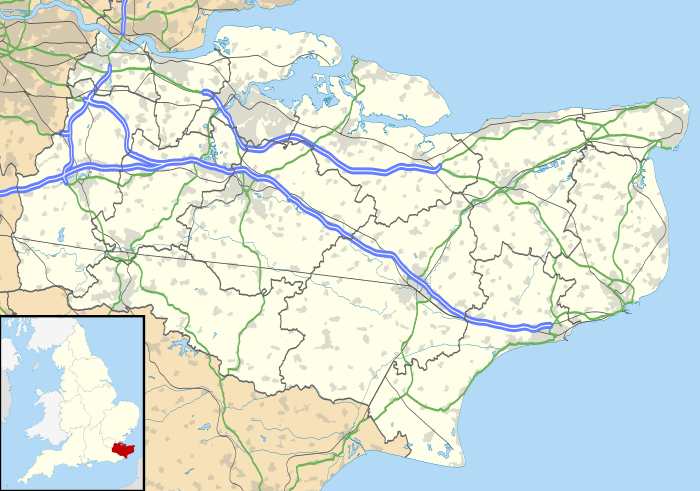 Kent, UK | |
| General information | |
| Architectural style | Castle |
| Town or city | Maidstone, Leeds |
| Country | UK |
| Coordinates | 51°14′55″N 0°37′48″E |
| Construction started | 1119 |
| Grounds | Built on islands in a lake formed by the River Len |
| Website | |
| https://www.leeds-castle.com | |
A castle has existed on the site since 1119, the first being a simple stone stronghold constructed by Robert de Crevecoeur which served as a military post in the time of Norman intrusions into England. In the 13th century it came into the hands of King Edward I, for whom it became a favourite residence; in the 16th century, Henry VIII used it as a dwelling for his first wife, Catherine of Aragon.
The present castle dates mostly from the 19th century. It has been open to the public since 1976.
History
Medieval and Tudor
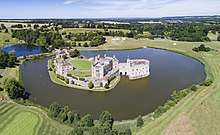
From 857 the site was owned by a Saxon chief called Led or Leed who built a wooden structure on two islands in the middle of the River Len.[1] In 1119 Robert de Crevecoeur rebuilt it in stone as a Norman stronghold and Leeds Castle descended through the de Crevecoeur family until the 1260s.[2] What form this Norman stronghold took is uncertain because it was rebuilt and transformed in the following centuries. Adrian Pettifer speculates that it may have been a motte and bailey.[3]
In 1278, the castle was bought by King Edward I's Queen, Eleanor of Castile. As a favoured residence of Edward's, it saw considerable investment. The king enhanced its defences, and it was probably Edward who created the lake that surrounds the castle. A barbican spanning three islands was also built and a gloriette with apartments for the king and queen was added.[4] In the Late Middle Ages, the growth of the royal household meant fewer residences could accommodate the monarchy when they visited. As a result, expenditure on royal residences in south east England generally decreased except for the Tower of London and Windsor Castle. The activity at Leeds Castle during the reign of Edward I was a notable exception to this pattern.[5]
The castle was captured on 31 October 1321 by the forces of Edward II from Margaret de Clare, Baroness Badlesmere, wife of the castle's constable, Bartholomew de Badlesmere, 1st Baron Badlesmere, who had left her in charge during his absence. The King had besieged Leeds after she had refused Edward's consort Isabella of France admittance in her husband's absence; when the latter sought to force an entry, Lady Badlesmere instructed her archers to fire upon Isabella and her party, six of whom were killed.[6] Lady Badlesmere was kept prisoner in the Tower of London until November 1322.[7] After Edward II died in 1327 his widow took over Leeds Castle as her primary residence.[8]
Richard II's first wife, Anne of Bohemia, spent the winter of 1381 at the castle on her way to be married to the king. In 1395, Richard received the French chronicler Jean Froissart there, as described in Froissart's Chronicles.
Henry VIII transformed the castle in 1519 for his first wife, Catherine of Aragon. A painting commemorating his meeting with Francis I of France still hangs there.
In 1552 Leeds Castle was granted to Sir Anthony St Leger (d.1559)[2] of Ulcombe, Kent, whose grandfather Ralph I St Leger (d.1470), of Ulcombe, Sheriff of Kent in 1467/8, had been Constable of Leeds Castle.
17th and 18th centuries
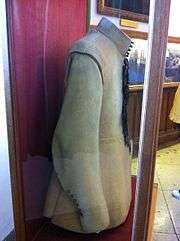
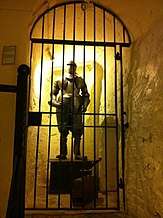
The castle escaped destruction during the English Civil War because its owner, Sir Cheney Culpeper, sided with the Parliamentarians. The castle was used as both an arsenal and a prison during the war. Other members of the Culpeper family had sided with the Royalists, John, 1st Lord Culpeper, having been granted more than 5,000,000 acres (20,000 km2) of land in Virginia in reward for assisting the escape of the king's son, Charles, the Prince of Wales.[9] This legacy was to prove vital for the castle's fortunes.
Thomas Fairfax, 6th Lord Fairfax of Cameron was born at the castle in 1693 and settled in North America to oversee the Culpeper estates, cementing an ongoing connection between the castle and America. There is a commemorative sundial at the castle telling the time in Belvoir, Virginia and a corresponding sundial in America.[9] Fairfax was the great grandson of Thomas Fairfax who led the parliamentarian attack at the nearby Battle of Maidstone in 1648 and whose doublet worn during the battle is on display.
19th century
.jpg)
Robert Fairfax owned the castle for 46 years until 1793 when it passed to the Wykeham Martins. Sale of the family estates in Virginia released a large sum of money that allowed extensive repair and the remodelling of the castle in a Tudor style, completed in 1823, that resulted in the appearance today.[9]
20th century
The last private owner of the castle was the Hon. Olive, Lady Baillie, daughter of Almeric Paget, 1st Baron Queenborough and his first wife, Pauline Payne Whitney, an American heiress. Lady Baillie bought the castle in 1926 for £180,000. She redecorated the interior, first working with the French architect and designer Armand-Albert Rateau, who oversaw exterior alterations and added interior features such as a 16th-century-style carved-oak staircase, then with the Paris decorator Stéphane Boudin. During the early part of World War II the castle was used as a hospital where Lady Baillie and her daughters hosted burned Commonwealth airmen as part of their recovery. Survivors remembered the experience with fondness. Upon her death in 1974, Lady Baillie left the castle to the Leeds Castle Foundation, a private charitable trust whose aim is to preserve the castle and grounds for the benefit of the public.[10] An estimated £1.4 million was invested and a further £400,000 was retrieved from the sale of the furniture to make improvements to the Castle and attract paying corporate conferences. However, it was quickly understood that it could not support the ongoing costs of running the Estate, so in 1975 the gardens were opened to the public, and the following year the Castle was also made available to visitors.[11]
On 17 July 1978, the castle was the site of a meeting between the Egyptian Foreign Minister Mohammed Ibrahim Karmel and Israeli Foreign Minister Moshe Dayan and Cyrus Vance of the US in preparation for the Camp David Accords.[9] The castle also hosted the Northern Ireland peace talks held in September 2004 led by Tony Blair.
Tourism
An aviary was added in 1980 and by 2011 it contained over 100 species, but it was decided to close it in October 2012 as it was felt the foundation could make better use of the £200,000 a year it cost to keep the aviary running.[14] The castle and its grounds are a major leisure destination with a maze that is exited through a shell grotto, a golf course and what may be the world's only museum of dog collars. There are two castle-themed children's adventure play areas targeted at the under sevens and the under fourteens.[15]
It is a Grade I listed building (first listed in 1952)[16] and recognised as an internationally important structure.[17] In 1998 Leeds Castle was one of 57 heritage sites in England to receive more than 200,000 visitors.[18] According to figures released by the Association of Leading Visitor Attractions, 465,706 people visited the castle in 2018.[19]
Film location
The castle was a location for the 1949 Ealing Comedy film Kind Hearts and Coronets, where it stood in for 'Chalfont', ancestral home of the aristocratic d'Ascoyne family.
It also appeared in the films The Moonraker (1958) and Waltz of the Toreadors (1962).
On the small screen, the castle and grounds provided all the filming locations for a Doctor Who serial, The Androids of Tara, in 1978. Sir Cliff Richard, filmed a live concert here, with Leeds Castle as a backdrop, titled, "Castles in the Air".[20]
Castle interior
- Dining room
- Banqueting hall
 Library
Library Thorpe Hall drawing room
Thorpe Hall drawing room
See also
References
- Notes
- Illustrated London News, January 1975
- Historic England, "Leeds Castle (418125)", PastScape, retrieved 14 March 2012
- Pettifer 1995, pp. 121–122
- Emery 2006, p. 304
- Emery 2006, p. 268
- Costain 1958, pp. 193–195
- McKisack 1959, p. 64 note 3
- Emery 2006, p. 305
- McCann 2002
- Charity Commission. LEEDS CASTLE FOUNDATION, registered charity no. 268354.
- "THE LEEDS CASTLE FOUNDATION". Leeds Castle Kent England.
- The Maze, Grotto and Turf Maze, Leeds Castle, retrieved 14 March 2012
- Fisher & Loxton 2007, p. 68
- "Leeds Castle to shut its aviary to save £200,000". BBC News. 12 October 2011. Retrieved 14 March 2012.
- Louise (2 April 2015). "A day trip to Leeds Castle, Kent - Globalmouse travels". Globalmouse travels. Retrieved 21 February 2017.
- Historic England, "Leeds Castle (1039919)", National Heritage List for England, retrieved 14 March 2012
- "Frequently asked questions", Images of England, English Heritage, archived from the original on 11 November 2007, retrieved 14 March 2012
- "Castle fires up tourists". BBC News. 30 August 1999. Retrieved 14 March 2012.
- "ALVA - Association of Leading Visitor Attractions". www.alva.org.uk. Retrieved 18 August 2019.
- openbuildings.com/
- Bibliography
- Costain, Thomas B. (1958), The Three Edwards, Doubleday and Company
- Emery, Anthony (2006), Greater Medieval Houses of England and Wales: Volume III Southern England, Cambridge University Press, ISBN 978-0-521-58132-5
- Fisher, Adrian; Loxton, Howard (2007), Secrets of the maze: an interactive guide to the world's most amazing mazes, Barnes & Noble, ISBN 978-0-7607-9073-1
- McCann, Nick (2002), Leeds Castle, ISBN 0-85101-374-0
- McKisack, May (1959), The Fourteenth Century, Oxford History of England
- Pettifer, Adrian (1995), English Castles: A Guide by Counties, Woodbridge: Boydell, ISBN 0-85115-782-3
Further reading
- Martin, Charles Wykeham (1869), The History and Description of Leeds Castle, Kent, Nichols and Sons


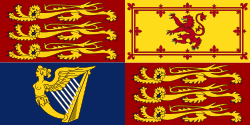
.svg.png)